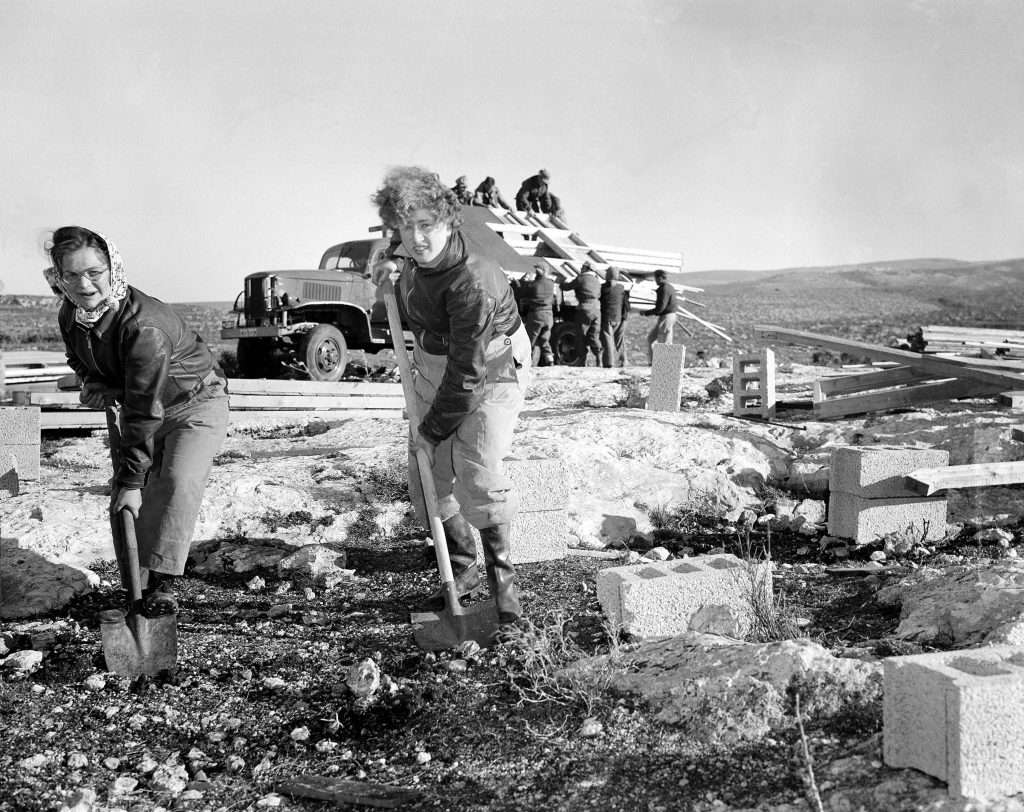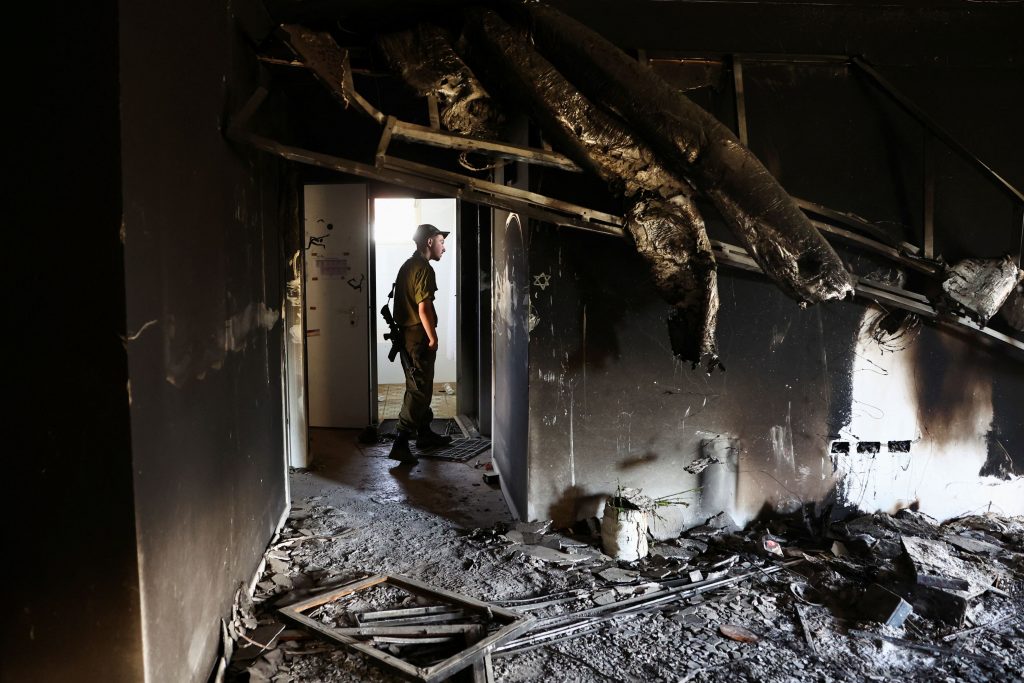Despite the discrepancy in size, Israel and the U.S. have always had much in common—rambunctious democracy, an ethos rooted in immigration, deep innovative and entrepreneurial success, and tragedy at age 75 that called into question their very existence. For the U.S., it was the Civil War; for Israel, the Hamas massacres of Oct. 7, 2023.
The war erupted at a time when in some respects Israel looked successful in ways that would have astonished the founding generation of 1948. In that year, the population consisted of roughly a million Jews (several hundred thousand newly landed from the displaced persons camps of Europe) and perhaps 150,000 Muslim and Christian Arabs, plus several other small minorities. In 2022, the population had burgeoned to nearly 10 million, over seven million of them Jews, making it larger than any Jewish diaspora community in the world for the first moment since ancient times.

Miriam Wiess, left, of Glasgow, Scotland, and Leah Cohen, of Leeds, help clear ground for the erection of a building at the site of the new Israeli kibbutz settlement in Yazur, in western Galilee, Israel, Feb. 13, 1949. (AP Photo)
The Israel of 1948 was poor; 75 years later it had a GDP of well over half a trillion dollars. In 1948, a military of 90,000 had to scrounge castoff weapons from Allied arms depots and a Communist Czechoslovakia selling German designs from World War II; in 2023, its military now numbered some 170,000 active-duty soldiers and 465,000 in the reserves, equipped with world-class weapons, many of indigenous design. An economy that relied heavily on exporting oranges in 1948 was now one of the technology powerhouses of the world, with multinational corporations and an abundance of technical inventions.
These achievements are stunning—indeed, unparalleled, because even a success story like Singapore didn’t do all this while absorbing millions of immigrants from around the world, of all skin colors, languages and traditions, while fighting chronic campaigns against its neighbors and terrorist groups committed to its extermination.
On Oct. 6, 2023, Israelis might have been excused for some complacency about their situation. Indeed, in previous months and years there was evidence of that. Israel was a “startup nation,” a country that according to the World Happiness Report (there is such a thing), ranked No. 4 after Finland, Denmark and Iceland. There is no statement of optimism like having children, and Israel’s high fertility rate was unique in the developed world.
Yet such confidence was misplaced because of three seemingly intractable problems.
A war legacy
The first of these was the legacy of the 1967 war.
After Israel’s war of independence in 1948-49, the majority of the Arab population that would have resided in the new state had moved—from fear or by compulsion or voluntary choice—to neighboring states a few miles away. The remaining minority was a politically insignificant 10% of Israel’s population.
But the 1967 war—launched after Egypt’s President Nasser blockaded the Straits of Tiran, evicted U.N. peacekeepers and assembled a coalition that he inspired with bloodthirsty rhetoric—changed all that. Israel occupied the West Bank of the Jordan and the Gaza Strip as well as the Sinai Peninsula and the Golan Heights.
This was, as Israeli journalist Shabtai Teveth called it, a cursed blessing. As the decades unfolded, Israelis motivated by religious and nationalist ideology or by the simple desire for open space moved to these areas, in a patchwork of communities that rendered a Palestinian state improbable, and that guaranteed permanent friction with the Arabs.
Moves to mitigate that friction, like the withdrawal from Gaza in 2005, failed, and Israel saw several waves of Palestinian violence that left both sides doubtful that the solution envisaged by the United Nations in 1947—two states, side by side, between the Jordan River and the sea—could ever exist. The situation has been exacerbated by the corruption of Palestinian governmental institutions, the fanaticism of terrorist movements like Hamas, and the continued slippage of Jewish extremists out of the control of the Israeli state. Barrier walls and brilliant intelligence work could mitigate violence, but not end it, and couldn’t resolve the fundamental problem: roughly equal numbers of Arabs and Jews live between the river and the sea.
Axis of irreconcilables
The wars of 1967, 1973 and 1982 convinced nearby Arab rulers that the Jewish state couldn’t be destroyed. The rise of Iran and of Islamist movements affiliated, however loosely, with the Muslim Brotherhood, led them to believe that Israel was the lesser threat. Israel’s military and industrial prowess convinced them that it might even be a useful if unloved partner.
The results were the peace treaties with Egypt, Jordan and more remote Arab states, the Abraham Accords leading to peace with the United Arab Emirates, and the not-so-secret reconciliation talks and tacit agreements with Saudi Arabia, once one of Israel’s most implacable enemies.
But meantime, a second intractable issue arose. A new axis of irreconcilables had formed—led by Iran, with clients and proxies in Lebanon, Syria, Yemen and abroad, and reinforced by Sunni Islamist movements that might hate Tehran’s Shi’a Islam, but hated Israel more. For the first time, the enemy state wasn’t merely far away but would soon have nuclear weapons. And even worse, could look to the open or covert support of two great powers, Russia and China.
Finally and most seriously, Israel on Oct. 6, 2023, faced a domestic crisis, resulting in part from structural problems—in particular, the growth of the ultra-Orthodox community that has great leverage in the political system but is a profound drag on the budget and policies of the state—and a misconceived and dangerously divisive set of policies by the Netanyahu government aimed at weakening Israel’s fiercely independent judiciary and advancing a form of plebiscitary authoritarianism.
And then, the massacre, on the heels of a catastrophic failure of military intelligence and preparedness, followed by an invasion of Gaza intended not merely to avenge the horrors, but to eliminate, once and for all, the political and military organization that bred them.

An Israeli soldier inspects a burnt house that has been abandoned for two months after the deadly October 7 attack by gunmen from Palestinian militant group Hamas from the Gaza Strip, in Kibbutz Beeri, southern Israel, December 7, 2023. REUTERS/Athit Perawongmetha
Amid the uncertainty
The uncertainties of the moment are immense, but a few things are clear.
The first is the striking resilience of Israeli civil society, despite an unpopular government that was led by a now largely despised prime minister into a disaster of epic proportions. Hundreds of thousands of Israelis fled not abroad, but home, many of them to don uniforms and join reserve units. Civil action groups, often the same as those demonstrating for months against the government, have filled in all kinds of gaps—from supplying soldiers to replacing labor on Israeli farms.
Second, there will be a reckoning when this ends. As in the past, Israel will undoubtedly have a state commission of inquiry. And as in the past, the judgments will no doubt be thorough and unsparing, and indeed will be preceded by resignations of those who hold themselves accountable. The trauma will be deep and enduring. This, after all, would be the equivalent of the U.S. losing some 40,000 people in a calculated rampage of rape, torture and murder in a single day.
Third, what will likely emerge in Israeli will be a new political consensus—possibly more hard-line on Palestinian questions, possibly not, but also likely more centrist on matters like judicial reform. The ultra-Orthodox community, already split in its response to the crisis, may be drawn more into the mainstream of Israeli society and crucially, its economy. A prolonged, and not unhealthy, soul-searching awaits a country once again under siege.
That is the main point. For nearly half a century, the existential question hasn’t been on the table for Israel.
After Oct. 7, however, Israelis will wonder whether they will live under the constant threat of an unshakably hostile and eliminationist coalition led by Iran and including Hezbollah, Hamas, Yemen’s Houthis and kindred groups that will use any means to weaken and eventually destroy their state.
They will wonder if the brilliant young men and women who drive the Israeli economy will stay. They will ask whether the more than 100,000 displaced persons will return to border settlements near Gaza and in the north. They will brace for new rounds of violence on the West Bank. They will ask whether, once again as in Israel’s first quarter-century, they will have to live under perpetual siege, building a society while keeping one wary hand ever on the sword.
They may have to, for at least the foreseeable future. History cannot guarantee how that will turn out, but the first Israelis accepted that challenge and still managed to thrive. Their spirit thus far suggests that one should not doubt that their grandchildren and great-grandchildren are capable of doing the same.
Eliot A. Cohen is a professor at Johns Hopkins School of Advanced International Studies and holds the Arleigh Burke chair in strategy at the Center for Strategic and International Studies. He can be reached at reports@wsj.com.
Corrections & Amplifications
Israel’s wars of 1967, 1973 and 1982, in the writer’s view, convinced nearby Arab rulers that the Jewish state couldn’t be destroyed. An earlier version of this article referred instead to wars in 1947, 1956, 1970 and 1982.


